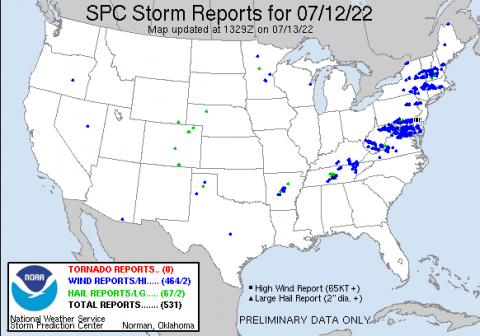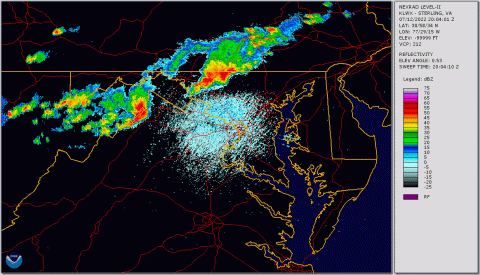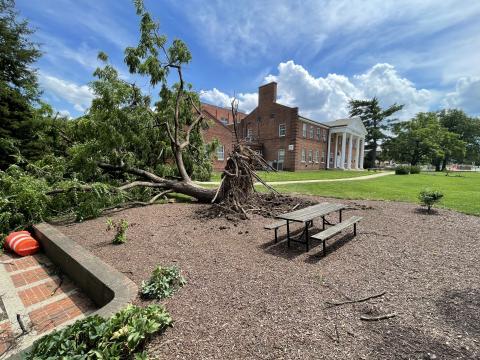August 31, 2022
Around 5 p.m. on Tuesday, July 12, severe thunderstorms hit the College Park area producing straight-line winds, hail, and heavy rain. Peak wind gusts estimated at 80-90 MPH (equivalent to a low-end EF1 tornado) caused tornado-like damage throughout the College Park area including widespread power outages, downed trees, flooding and building damage.
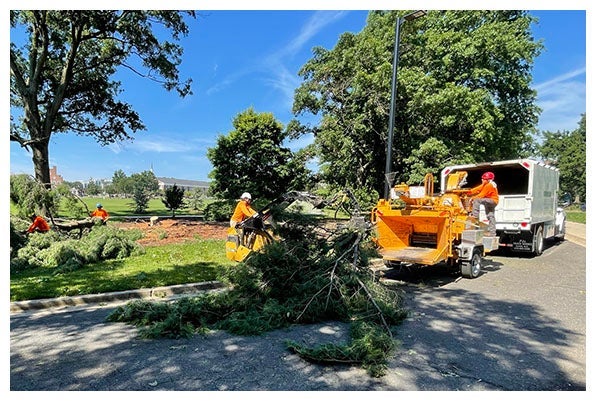
The storm knocked out all three 13.8 kV feeders to the Mowatt Lane electrical substation, resulting in a multiday loss of power across campus including the loss of many critical systems.
- Roof damage was reported at over 20 campus buildings.
- Water intrusion was reported at 20 campus buildings.
- High winds damaged over 400 landscape trees and teaching specimens, over 250 golf course trees, and caused significant damage to entire woodland areas including permanent forest conservation easements.
With widespread power outages and damage across campus, the university remained closed on Wednesday with classes and activities canceled. In the hours and days following the storm, FM teams worked around the clock to assess damage, clear roadways, and restore power.
The Response Begins
Shortly after the storm began its damaging run, Glynnis Bowman stood up Incident Command. The Office of Emergency Management and Business Continuity convened the Campus Incident Coordination Group, bringing together staff from across the university, including many from FM, on a conference bridge call to share information and increase situational awareness. The group convened 8 times in response to the July 12 storm.
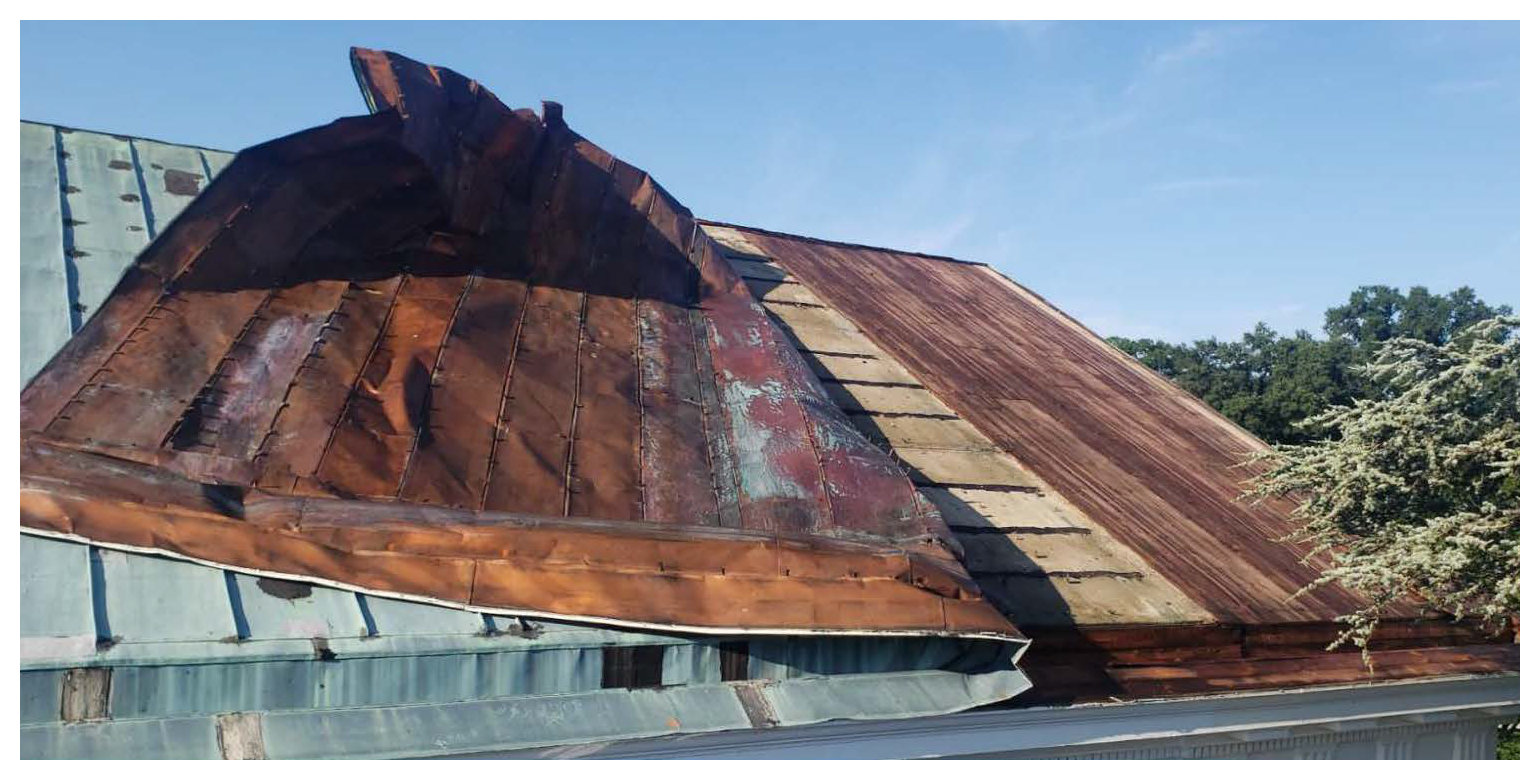
According to Glynnis, in those first hours, reconnaissance and response were key. Teams from across FM focused on identifying locations impacted by the storm and determining the appropriate response. Staff from the Incident Response Unit (IRU), Landscape, Area Maintenance, HVAC, and Engineering and Energy were vital to these operations.
But early response was not without its challenges. FM team members returning to campus after hours that evening encountered downed trees and heavy branches blocking roads. Tom Abell, Assistant Manager of Area Maintenance found himself briefly directing traffic around one campus road closure before he could report to campus.
To improve safety and navigation across campus, Landscape Services focused on downed trees and limbs that were blocking campus roads. But the power outage caused dark and dangerous conditions for work teams. To avoid operating chainsaws in wet, slippery, low-visibility conditions, landscape teams were sent home as soon as major roadways were cleared. They would return at daylight to begin the massive effort of dealing with nearly 400 damaged trees.
Regaining Control
The power outage on campus lasted around 30 hours, from 6 p.m. on July 12 until around noon on July 14 and occurred when damage to Pepco equipment triggered (and damaged) UMD lightning arrestors. The power outage was area-wide throughout College Park and UMD teams worked alongside Pepco crews to make repairs as quickly as possible. Backup power – diesel or natural gas-powered generators – kept critical systems functional during the outage.
In daylight, Landscape Services was better able to assess the damage. Using the campus tree inventory created in conjunction with FM’s GIS team, they were able to pinpoint damage to individual trees on a map and maintain an accurate assessment of what needed to be done. With roadways cleared on the night of the storm, Landscape Services teams began clearing walkways and removing trees or branches that fell on campus buildings. Other teams worked at the edges of campus where damage from UMD trees affected 40 homeowners.
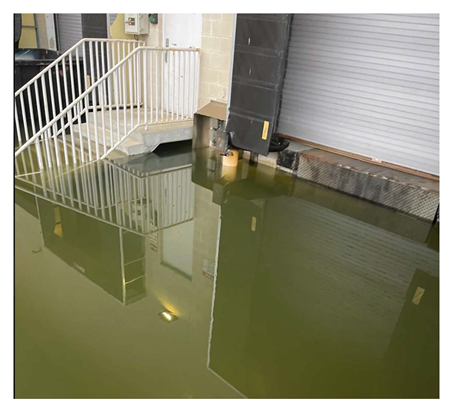
IRU and Area Maintenance began to quickly restore order in flooded buildings where water entered through damaged roofs, overwhelmed drains, or foundation leaks. Both teams used vehicles stocked with flood control equipment such as generators, sump pumps, wet-vacs and squeegees to address areas most urgently in need of attention. IRU head Brian Trest noted that the IRU’s relocation to Nyumburu Cultural Center provided a strategic advantage – the centrally located position allowed for a quicker deployment of emergency equipment.
By 10 a.m. on Thursday, roads and sidewalks were passable, was power was restored, and campus reopened.
Learning from the Experience
After-incident debriefings provided an opportunity for FM leaders to review and broadly assess the storm response identifying lessons learned, successes, and opportunities for improvement. High on the list of possible changes included preventative maintenance for buildings susceptible to flooding and staff shift adjustments.
Deputy Director of FM’s Operations and Maintenance group Rob Hermstein emphasized that this summer has given us notice of things to come. Since the beginning of June, the College Park area has endured four storms dropping the equivalent of four inches of rain per hour and water drainage systems designed to handle two inches of rain per hour are no longer adequate. Climate change has created the need to plan for intense rain events that may occur with more frequency and severity – an important consideration as FM’s Facilities Planning department develops the next 10-year Facilities Master Plan.
Below is a NOAA figure showing the density of SPC storm reports on the 12th and a reflectivity animation of the storm's progress provided to us by Joel Dreessen of the Maryland Department of the Environment.
AOSC Professor Jonathan Poterjoy remarks: "Most of the damage was probably caused by the rear inflow jet associated with the bow echo. Subsidence (caused by a variety of factors) can cause this jet to reach the surface, causing very strong straight-line winds."

